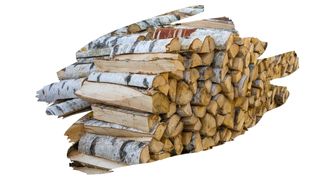Making your own furniture is a great way to create a custom piece that compliments the aesthetic of your home. But there are so many different aspects of woodworking that can effect the durability of your wood furniture.
Yet, when it comes to exact wood seasoning methods, can this too also impact the quality of furniture?
Well, in this post you will find out whether or not kiln dried wood is really safe enough to use for interior furniture. You will also learn why kiln drying wood makes wood more stable than traditional air drying.
And keep reading to discover whether or not kiln drying can actually make wooden furniture stronger…

This post may contain affiliate links to products that we receive a commission for (at no additional cost to you). Learn more here.
Is Air Dried Wood The Same Quality As Kiln Dried Wood?
It is of slightly lesser quality, but not for the reason you might think.
Air dried wood has been seasoned by allowing it to air-dry over a number of months. Over 6-12 months, moisture content levels inside wood fall from a fresh 100%, down to less than 19%.
However, Kiln dried wood is heated in a kiln oven. It takes mere days to kiln dry wood down to moisture content levels as low as 12%.
Yet, there are two key advantages to kiln dried wood that make it better quality than air dried wood.
1). Less Moisture = More Stable
Kiln dried wood is more stable than air dried wood. That’s because it’s less likely to shrink as a result of its moisture content continuing to fall (after seasoning).
When moisture evaporates out of wood fibers, wood shrinks down, throwing off your initial measurements. And sometimes this can even lead to cracking and splitting.
So, if there’s very little moisture left in wood, there’s much less shrinkage happening as a result.
2). Kiln Heat = Fewer Bugs
Wood is a natural material. It can absorb water, and rot away, if it is not properly sealed.
And, once this material becomes damp, wood becomes soft enough for bugs to eat into to. So, freshly cut lumber, (thats been left out to dry), can sometimes have little munching bugs and critters in it.
However, kiln drying wood will get rid of any wood eating bugs that may be hanging around.
Related Post: How To Season Wood (7 Tips)
But Is Kiln Dried Wood Safe To Have In The House?
Absolutely. There is nothing inherently unsafe about kiln drying wood.
Untreated kiln dried wood has simply been dried out using heat. There are no chemical treatments or fumigating toxins added to the wood during this process.
But, if that kiln-dried wood is stamped as KDAT (Kiln Dried After Treatment) then that’s a different matter.
KDAT wood will have been treated with water-soluble fungicides designed to prevent the growth of wood rot bacteria. And depending on the type of chemicals used, KDAT wood may not be suitable for interior furniture pieces.
Related Post: What’s The Difference Between Kiln Dried Wood Vs Pressure Treated Timber?
But Is Kiln Dried Wood Really That Much Better For Making Sturdy Furniture?
Kiln drying the wood, (i.e. lower moisture content), doesn’t actually increase the overall strength and toughness of wood itself. It does, however, make it more stable. And this, in turn, can improve the durability of furniture.
Having said that, the difference in stability between kiln drying and air drying wood isn’t that stark. The way you seal the wood up afterwards has a much bigger impact on stability, than your method of seasoning.
Instead, the advantage to kiln drying, is that:
- 1). Quick-drying freshly cut lumber minimizes the chances of bacteria growing on it.
- 2). Using a kiln oven gets rid of bugs before they can burrow into lumber.
- 3). The lack of moisture stabilizes the wood, reducing the chance of fine splits and cracks.
- 4). The lack of moisture also reduces the chance of rot taking hold in wood.
But What Are The Main Disadvantages Of Using Kiln Dried Wood For Furniture?
Time and/or Expense.
If you’re kiln-drying wood yourself, you’ll need to constantly monitor that lumber for days on end. On the other hand, air drying wood is more of a set-and-forget approach.
And whether you purchase kiln dried wood or not, there’s extra expense involved in this seasoning method.
Kiln dried wood is more expensive. And creating (or purchasing) wood kiln-ovens isn’t cheap either.
Related Post: Is Kiln Dried Wood Safe Enough To Use For Gardens And Landscaping?
And Will Kiln Dried Wooden Furniture Crack?
If it isn’t correctly finished and sealed, then it certainly can. Nevertheless, its less likely to happen compared to furniture made from air dried wood.
But to be clear, kiln drying doesn’t wholly prevent unsealed wood from absorbing moisture, or cracking apart.
To Wrap Up, Here Are The 3 Key Takeaways From This Post…
- 1). Kiln dried wood has been seasoned using a kiln-oven. This allows us to get the moisture content of wood down to as low as 12%.
- 2). Kiln dried wood is more stable and less likely to crack and split, due to its lower moisture content.
- 3). Kiln drying wood has fewer imperfections in it, (after seasoning), compared to air dried wood.
References:
Shahverdi, M., Tarmian, A., Dashti, H., Ebrahimi, G., and Tajvidi, M. (2012). “Mechanical properties of poplar wood (Populus alba) dried by three kiln drying schedules,” BioRes. 7(1), 1092-1099.



